Throughout the year, our district provides ongoing professional development from the Reading and Writing Project at Teachers College of Columbia University (TCRWP). Staff developers visit our district and do demonstration lessons, provide coaching, and lead study groups around reading and writing workshops and content area literacy instruction. They always share innovative tools and ideas, so when Staff Developer Heather Burns suggested demonstrating a Question Formulation Technique (QFT) within a reading class, I was intrigued. We’ve written the QFT into some of our social studies units, and I’ve also used it within information writing units. Watching this technique move from content areas to language arts instruction was exciting, especially coming from a literacy specialist, and it made me want to try it with my own literacy lesson.
Since Heather’s presentation, I have duplicated the 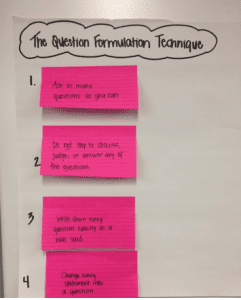 work. In a fifth-grade classroom, I shared the following chart with the students. It is important for them not only to hear the ground rules of generating questions before they get going, but also to have a visual reminder. We have even made this chart into individual-sized versions to help students internalize the concept that they are to just write down the questions as they are asked without stopping to judge, discuss, or answer any of them.
work. In a fifth-grade classroom, I shared the following chart with the students. It is important for them not only to hear the ground rules of generating questions before they get going, but also to have a visual reminder. We have even made this chart into individual-sized versions to help students internalize the concept that they are to just write down the questions as they are asked without stopping to judge, discuss, or answer any of them.
Once we presented and reviewed the QFT protocol, we presented students with a statement about the setting, challenging them to have their questions focus on the role of the setting at the beginning stages of a historical fiction reading unit we were doing. We were not only building background knowledge around specific historical time periods, but also teaching students to approach this genre with more of an awareness and concern about the time and place. During this lesson, we used the picture book, Coming on Home Soon by Jacqueline Woodson. This story is set in a rural town during World War II. Ada Ruth is an African American girl whose mother temporarily leaves her in order to work in Chicago, filling in for what were typically men’s jobs.
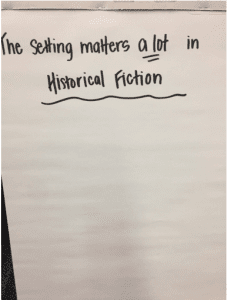
Picking a focus for generating questions is a critical step in the QFT process. Arriving at a strong QFocus involves choosing a statement, picture, short movie clip, or other source that will spark enough curiosity that students are excited to ask and generate questions but not so broad that students struggle to get started. Before deciding on a focus, I recommend trying it out yourself. If it’s hard for you to think of questions about it, you can bet that students will struggle as well. The goal is to create authentic wonder.
Even with the protocol chart in place, the rules were difficult for students to follow. We divided the class into five groups of four or five students. We noticed a significant variation in how many questions groups could come up with–one group filled a paper and then some, while another group struggled to think of six questions. All of the groups needed many reminders to write the questions down without discussing or judging them. However, once the groups internalized this important concept, the production of questions really increased.

We taught this class about open-ended and closed-ended questions earlier in the year, but we decided to review this concept as a whole group activity. For the sake of clarity, we defined closed-ended questions as ones in which one word or just a few words would answer them. For example, “where did Ada Ruth live?” would be a closed-ended question.
We asked groups to select their most important questions–the ones which would inspire them to say the most about–and we collected those on one master chart. Using those questions, we categorized the questions, coding them with a C and an O for open and closed, reviewing the types of questions, and explicitly teaching students how to change closed-ended questions into open-ended questions, and vice-versa. When groups had similar questions, we made tallies to indicate others had the same ones. Once we completed this process, we had students choose which question they wanted to explore in their reader’s notebooks.
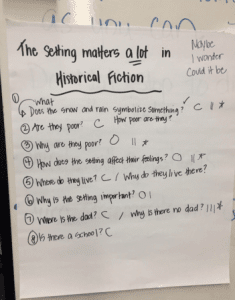
The work that students did in their notebooks after this experience went far beyond the surface level plot summaries we sometimes see. Every student was engaged and invested in the work they were doing as they explored possible explanations for their questions. Many of the students were concerned about the role of the father, and they related it to the setting because they theorized he may be missing because of the war or the economic pressures of the times. I’ve shared some of the notebook samples. As you can see in the first sample, the student moves into prediction and theorizing and away from just plot summary.
In the second student sample, the student develops more analysis of the setting and the stresses on the characters and their relationships. This sort of work again pushes students beyond summary and plot, moving into the more sophisticated realm of interpretation.
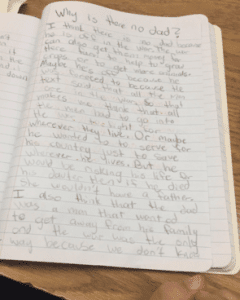

Perhaps one of the most exciting results of this lesson is how is has evolved in subsequent days. We did this first QFT as a whole class activity, and all of the students asked questions about the same picture book. However, the second QFT challenged book clubs to engage in this work with their own specific text. Because they understood the process, their questions had the potential to lead to deeper thinking during the development phase as opposed to during later steps in the process. One student even explicitly explained how he was working on making sure that any question he asked would be one that could inspire a lengthy explanation. In this way, he demonstrated how he was internalizing the important skill of asking questions, but he was also pushing himself to ask questions that required interpretation and analysis.
In so much of the work I do with students, my goal is to inspire them to think as opposed to answer. The QFT is a powerful instructional practice that inspires a curious habit of mind, as it invites students to share the responsibility of asking questions of themselves and one another.
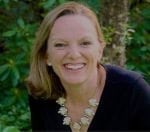
Melanie Meehan began her teaching career in 1992 as a special education teacher at a residential school for elementary students. She learned about the writing workshop model, attended a week-long course given by Katie Wood Ray, and has been a believer ever since. After ten years at home raising her four daughters, Melanie returned to teaching special education in 2008 and has been the Elementary Writing and Social Studies Coordinator in Simsbury, CT since 2011. Melanie is passionate about developing young writers, as well as human beings with curiosity, empathy, and responsibility for the world we all share. She is a regular contributor to Choice Literacy and Lead Literacy. was a member of the writing team for the Connecticut Social Studies Frameworks, and she shares a blog, Two Reflective Teachers, with Melanie Swider.
Melanie holds a B.A from Cornell University, a Masters in Special Education from the University of Hartford, and her Sixth Year in Educational Leadership from Central Connecticut State University. In addition to writing professionally, Melanie loves to write narrative stories and is working on her Masters in Creative Writing, as well as several fictional stories. She has published articles in Highlights Magazine, and won the 2016 Tassy-Walden Award for New Voices in Children’s Literature. You can find her on Twitter @MelanieMeehan1.
